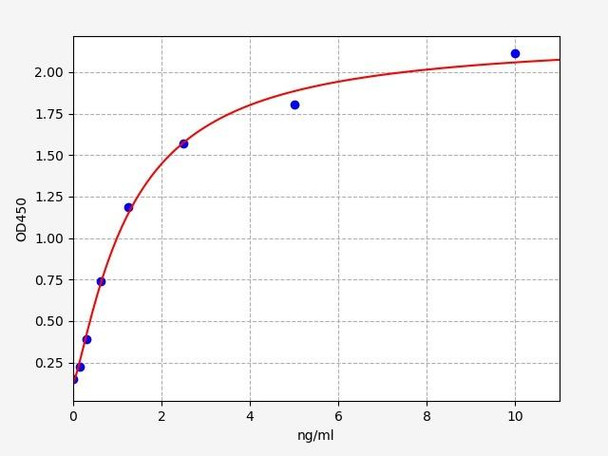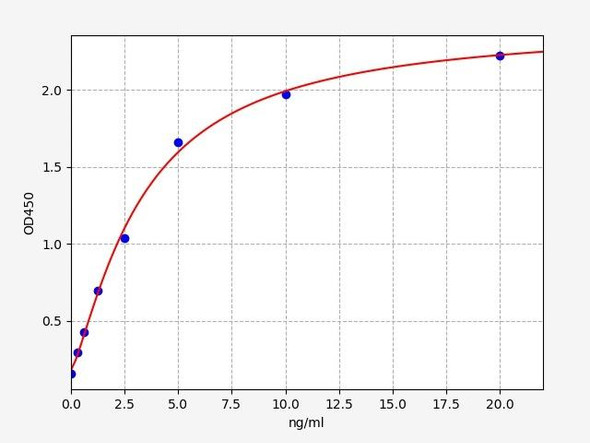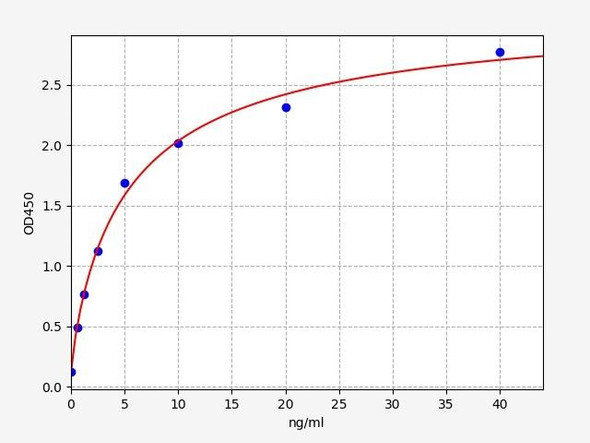Mouse GLUT4 / Glucose Transporter 4 ELISA Kit
- SKU:
- MOFI00857
- Product Type:
- ELISA Kit
- Size:
- 96 Assays
- Uniprot:
- P14142
- Sensitivity:
- 0.094ng/ml
- Range:
- 0.156-10ng/ml
- ELISA Type:
- Sandwich
- Synonyms:
- GLUT4, SLC2A4, Solute carrier family 2, facilitated glucose transporter member 4, Glucose transporter type 4, insulin-responsive, GLUT-4, GLUT-4, insulin-responsive glucose transporter type 4
- Reactivity:
- Mouse
- Research Area:
- Signal Transduction
Description
Mouse GLUT4/Glucose Transporter 4 ELISA Kit
The Mouse GLUT4 (Glucose Transporter 4) ELISA Kit is specifically designed for the precise measurement of GLUT4 levels in mouse serum, plasma, and cell culture supernatants. With its excellent sensitivity and specificity, this kit ensures dependable and consistent results, making it well-suited for a variety of research purposes.GLUT4 is a critical transporter protein responsible for glucose uptake in cells, playing a crucial role in regulating blood sugar levels and insulin signaling.
Dysregulation of GLUT4 is linked to conditions like diabetes, obesity, and metabolic disorders, making it a valuable biomarker for understanding these diseases and exploring potential treatment strategies.This ELISA kit provides researchers with a valuable tool for quantifying and studying GLUT4 levels in mouse models, offering insights into the molecular mechanisms underlying glucose metabolism and providing opportunities for developing novel therapeutic interventions.
| Product Name: | Mouse GLUT4 / Glucose Transporter 4 ELISA Kit |
| Product Code: | MOFI00857 |
| Size: | 96 Assays |
| Alias: | GLUT4, SLC2A4, Solute carrier family 2, facilitated glucose transporter member 4, Glucose transporter type 4, insulin-responsive, GLUT-4, GLUT-4, insulin-responsive glucose transporter type 4 |
| Detection Method: | Sandwich ELISA |
| Application: | This immunoassay kit allows for the in vitro quantitative determination of Mouse GLUT4 concentrations in serum plasma and other biological fluids. |
| Sensitivity: | 0.094ng/ml |
| Range: | 0.156-10ng/ml |
| Storage: | 4°C for 6 months |
| Note: | For Research Use Only |
| Recovery: | Matrices listed below were spiked with certain level of Mouse GLUT4 and the recovery rates were calculated by comparing the measured value to the expected amount of Mouse GLUT4 in samples. | ||||||||||||||||
| |||||||||||||||||
| Linearity: | The linearity of the kit was assayed by testing samples spiked with appropriate concentration of Mouse GLUT4 and their serial dilutions. The results were demonstrated by the percentage of calculated concentration to the expected. | ||||||||||||||||
| |||||||||||||||||
| Intra Assay: | CV <8% | ||||||||||||||||
| Inter Assay: | CV <10% |
| Component | Quantity | Storage |
| ELISA Microplate (Dismountable) | 8×12 strips | 4°C for 6 months |
| Lyophilized Standard | 2 | 4°C/-20°C |
| Sample/Standard Dilution Buffer | 20ml | 4°C |
| Biotin-labeled Antibody(Concentrated) | 120ul | 4°C (Protect from light) |
| Antibody Dilution Buffer | 10ml | 4°C |
| HRP-Streptavidin Conjugate(SABC) | 120ul | 4°C (Protect from light) |
| SABC Dilution Buffer | 10ml | 4°C |
| TMB Substrate | 10ml | 4°C (Protect from light) |
| Stop Solution | 10ml | 4°C |
| Wash Buffer(25X) | 30ml | 4°C |
| Plate Sealer | 5 | - |
Other materials and equipment required:
- Microplate reader with 450 nm wavelength filter
- Multichannel Pipette, Pipette, microcentrifuge tubes and disposable pipette tips
- Incubator
- Deionized or distilled water
- Absorbent paper
- Buffer resevoir
| Uniprot | P14142 |
| UniProt Protein Function: | GLUT4: an integral membrane facilitative glucose transporter. One of 13 members of the human equilibrative glucose transport protein family. Its surface expression is regulated by insulin. Has two internalization sequences, a dileucine repeat present in the C-terminus and a FxxY motif in the amino-terminal end. Associates with an intracellular tubulo-vesicular compartment under low plasma conditions. The binding of insulin to the insulin receptor (a typosine kinase) leads to the rapid translocation of GLUT4 to the cell surface, increasing cellular glucose transport activity. Its translocation to the plasma membrane is also stimulated by exercise, but independent from insulin signaling. This insulin-independent pathway may be regulated by AMPK. |
| UniProt Protein Details: | Protein type:Membrane protein, multi-pass; Transporter; Membrane protein, integral; Transporter, SLC family Cellular Component: cell surface; clathrin-coated vesicle; coated pit; cytoplasm; cytoplasmic vesicle membrane; cytosol; endomembrane system; endosome; external side of plasma membrane; integral to membrane; integral to plasma membrane; intracellular membrane-bound organelle; lipid raft; membrane; multivesicular body; perinuclear region of cytoplasm; plasma membrane; sarcolemma; T-tubule; trans-Golgi network transport vesicle; vesicle; vesicle membrane Molecular Function:D-glucose transmembrane transporter activity; glucose transmembrane transporter activity; insulin-responsive hydrogen:glucose symporter activity; protein binding; substrate-specific transmembrane transporter activity; transmembrane transporter activity; transporter activity Biological Process: amylopectin biosynthetic process; brown fat cell differentiation; carbohydrate transport; cellular response to insulin stimulus; glucose homeostasis; glucose transport; transmembrane transport; transport |
| UniProt Code: | P14142 |
| NCBI GenInfo Identifier: | 341941082 |
| NCBI Gene ID: | 20528 |
| NCBI Accession: | P14142.3 |
| UniProt Secondary Accession: | P14142,Q3TPK6, Q9JJN9, |
| UniProt Related Accession: | P14142 |
| Molecular Weight: | 54,755 Da |
| NCBI Full Name: | Solute carrier family 2, facilitated glucose transporter member 4 |
| NCBI Synonym Full Names: | solute carrier family 2 (facilitated glucose transporter), member 4 |
| NCBI Official Symbol: | Slc2a4 |
| NCBI Official Synonym Symbols: | Glut4; Glut-4 |
| NCBI Protein Information: | solute carrier family 2, facilitated glucose transporter member 4 |
| UniProt Protein Name: | Solute carrier family 2, facilitated glucose transporter member 4 |
| UniProt Synonym Protein Names: | GT2; Glucose transporter type 4, insulin-responsive; GLUT-4 |
| UniProt Gene Name: | Slc2a4 |
| UniProt Entry Name: | GTR4_MOUSE |
*Note: Protocols are specific to each batch/lot. For the correct instructions please follow the protocol included in your kit.
| Step | Procedure |
| 1. | Set standard, test sample and control (zero) wells on the pre-coated plate respectively, and then, record their positions. It is recommended to measure each standard and sample in duplicate. Wash plate 2 times before adding standard, sample and control (zero) wells! |
| 2. | Aliquot 0.1ml standard solutions into the standard wells. |
| 3. | Add 0.1 ml of Sample / Standard dilution buffer into the control (zero) well. |
| 4. | Add 0.1 ml of properly diluted sample (Human serum, plasma, tissue homogenates and other biological fluids.) into test sample wells. |
| 5. | Seal the plate with a cover and incubate at 37 °C for 90 min. |
| 6. | Remove the cover and discard the plate content, clap the plate on the absorbent filter papers or other absorbent material. Do NOT let the wells completely dry at any time. Wash plate X2. |
| 7. | Add 0.1 ml of Biotin- detection antibody working solution into the above wells (standard, test sample & zero wells). Add the solution at the bottom of each well without touching the side wall. |
| 8. | Seal the plate with a cover and incubate at 37°C for 60 min. |
| 9. | Remove the cover, and wash plate 3 times with Wash buffer. Let wash buffer rest in wells for 1 min between each wash. |
| 10. | Add 0.1 ml of SABC working solution into each well, cover the plate and incubate at 37°C for 30 min. |
| 11. | Remove the cover and wash plate 5 times with Wash buffer, and each time let the wash buffer stay in the wells for 1-2 min. |
| 12. | Add 90 µL of TMB substrate into each well, cover the plate and incubate at 37°C in dark within 10-20 min. (Note: This incubation time is for reference use only, the optimal time should be determined by end user.) And the shades of blue can be seen in the first 3-4 wells (with most concentrated standard solutions), the other wells show no obvious color. |
| 13. | Add 50 µL of Stop solution into each well and mix thoroughly. The color changes into yellow immediately. |
| 14. | Read the O.D. absorbance at 450 nm in a microplate reader immediately after adding the stop solution. |
When carrying out an ELISA assay it is important to prepare your samples in order to achieve the best possible results. Below we have a list of procedures for the preparation of samples for different sample types.
| Sample Type | Protocol |
| Serum: | If using serum separator tubes, allow samples to clot for 30 minutes at room temperature. Centrifuge for 10 minutes at 1,000x g. Collect the serum fraction and assay promptly or aliquot and store the samples at -80°C. Avoid multiple freeze-thaw cycles. If serum separator tubes are not being used, allow samples to clot overnight at 2-8°C. Centrifuge for 10 minutes at 1,000x g. Remove serum and assay promptly or aliquot and store the samples at -80°C. Avoid multiple freeze-thaw cycles. |
| Plasma: | Collect plasma using EDTA or heparin as an anticoagulant. Centrifuge samples at 4°C for 15 mins at 1000 × g within 30 mins of collection. Collect the plasma fraction and assay promptly or aliquot and store the samples at -80°C. Avoid multiple freeze-thaw cycles. Note: Over haemolysed samples are not suitable for use with this kit. |
| Urine & Cerebrospinal Fluid: | Collect the urine (mid-stream) in a sterile container, centrifuge for 20 mins at 2000-3000 rpm. Remove supernatant and assay immediately. If any precipitation is detected, repeat the centrifugation step. A similar protocol can be used for cerebrospinal fluid. |
| Cell culture supernatant: | Collect the cell culture media by pipette, followed by centrifugation at 4°C for 20 mins at 1500 rpm. Collect the clear supernatant and assay immediately. |
| Cell lysates: | Solubilize cells in lysis buffer and allow to sit on ice for 30 minutes. Centrifuge tubes at 14,000 x g for 5 minutes to remove insoluble material. Aliquot the supernatant into a new tube and discard the remaining whole cell extract. Quantify total protein concentration using a total protein assay. Assay immediately or aliquot and store at ≤ -20°C. |
| Tissue homogenates: | The preparation of tissue homogenates will vary depending upon tissue type. Rinse tissue with 1X PBS to remove excess blood & homogenize in 20ml of 1X PBS (including protease inhibitors) and store overnight at ≤ -20°C. Two freeze-thaw cycles are required to break the cell membranes. To further disrupt the cell membranes you can sonicate the samples. Centrifuge homogenates for 5 mins at 5000xg. Remove the supernatant and assay immediately or aliquot and store at -20°C or -80°C. |
| Tissue lysates: | Rinse tissue with PBS, cut into 1-2 mm pieces, and homogenize with a tissue homogenizer in PBS. Add an equal volume of RIPA buffer containing protease inhibitors and lyse tissues at room temperature for 30 minutes with gentle agitation. Centrifuge to remove debris. Quantify total protein concentration using a total protein assay. Assay immediately or aliquot and store at ≤ -20 °C. |
| Breast Milk: | Collect milk samples and centrifuge at 10,000 x g for 60 min at 4°C. Aliquot the supernatant and assay. For long term use, store samples at -80°C. Minimize freeze/thaw cycles. |









